Baboons on the Roof and a Lonely Elephant
Akagera National Park
Rwanda is a tiny country, but it offers great variety in its landscape. Western Rwanda, like the neighboring Congo, is famous for its volcanoes, deep forests, and mountain gorilla populations. Akagera National Park is entirely different.
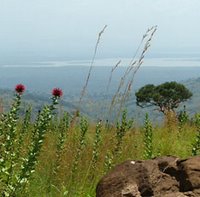 Located in the east on the Tanzanian border, the park is the only place in the country where a visitor can experience the classic African safari: savannah bush land, giraffes, zebra, crocodiles, and hippos. Going on safari in Akagera, however, is not as much of a vacation as it is in other countries (see BLOG). Seeing the park itself is absolutely worth the trip, but arranging transportation and accommodation was more stressful than it should have been.
Located in the east on the Tanzanian border, the park is the only place in the country where a visitor can experience the classic African safari: savannah bush land, giraffes, zebra, crocodiles, and hippos. Going on safari in Akagera, however, is not as much of a vacation as it is in other countries (see BLOG). Seeing the park itself is absolutely worth the trip, but arranging transportation and accommodation was more stressful than it should have been.
To be fair, Internet research is a dangerous thing. Naively, I believed that a random blogger's picture of Akagera Game Lodge was in fact depicting the Akagera Game Lodge, and I expected rustic comfort. After our bouncy, dusty journey to the park, however, I was not greeted by the sight of cozy thatched chalets in the bush. Nor was I welcomed by the sound of cooing doves or laughing hippos. Instead, brick walls and metal staircases loomed in front of me as I jumped out of the car. In place of a watering hole, an artificially blue swimming pool peeked out from the back garden.
The lodge is, in fact, a pleasant enough place. It has tasty food, decent wine, comfortable rooms, and a trilingual staff. But it practically bustles with activity until dark - I am beginning to understand that Rwandan hotels always seem crowded until dinnertime, when everyone who came to sip Coke beside the swimming pool goes home - and it is far too people-centric to be truly relaxing. One does not leave with the impression that man and beast coexist peacefully, which is a shame because the park itself is so scenic and tranquil.
When Animals Ruled the Earth
The best hour I spent at the lodge was from 5:30 to 6:30 am before everyone else was awake. Urged by an earnest travel companion, I rose early, layered on several sweaters, shuffled out to the poolside deck, plunked obediently into a chair, and waited for the orange sun to pull itself above the clouds.
Gradually, I became aware that the neatly shingled hotel roof was covered with large bumps. My ears registered scratching, and the shapes began to move. One shrieked. A troop of twenty baboons had parked themselves on the roof. All of them, like monks, faced the sunrise; and as the sun's light crawled across the roof, some of them began to play. As my companion poetically noted, the entire lodge suddenly became their jungle gym. They swung from balconies, climbed columns, perched on tables, and slid down railings. On the upper patio, a waiter suddenly appeared from the restaurant carrying a large room service tray. Several baboons watched him go by as they ripped flowers out of the planters, chewed off the roots, and then tossed them into the courtyard below. Three more tailed him down the hall.
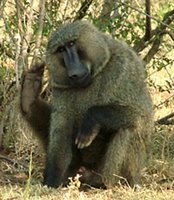
As the light increased, the baboons were gradually shown the door by the hotel staff, who circled the grounds waving their arms and yelling. By eight, the whole troop had galloped huffily back into the bush.
We weren't the only ones enjoying a stunning buffet that morning. On my way to breakfast I learned that baboons are omnivores. As I approached the restaurant, I saw a man quietly sweeping up the bloody sparrows' wings that were scattered among the debris of potting soil, chewed up plants, and feathers. My delight at the thought of the lodge's assortment of freshly made omelets was somewhat diminished as I picked my way around the mutilated birds.
Mutual Fascination
Our first game drive was a short tour near the lodge, and it was wildly successful. I expected neither volume nor variety of animals, as Akagera has been called an evaporating park. Not only have war and poaching severely deplete the number of animals living in the park, but 65 percent of the land has been confiscated and redistributed to returned refugees. In our first two hours, though, we were pleasantly surprised by both the beauty of the land and its variety of wildlife.
Despite the human turmoil that they have witnessed, the Akagera animals are not shy. After thirty minutes of weaving up and down the red rocky slopes, our vehicle emerged into a thorny clearing dotted with acacia trees. We growled along for a minute and then shuddered to a stop. The guide told us to climb onto the top of the car. Soon we spotted a pair of giraffes, a mother and baby, approaching across the clearing. The thorn bushes were four feet tall, so all we could see were two spindly necks bobbing towards us. Suddenly the huge animals burst into the path right in front of our car. Both of them paused, earnestly studying us. The baby was especially curious about the funny creatures in front of him and stared for a long time. Then his mother rustled back into the brush, ambling off into the distance, and he followed.
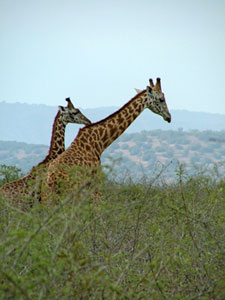
Later on, we passed by a herd of sleeping buffalo. I only mention this encounter because our guide suggested that we try to wake them up by driving into them. To his disappointment, all of us (especially the driver) voted down this scheme; but when I spotted a baby bush bunny camouflaged in the tall grass, he excitedly jumped out of the car to try and catch it. All the buffalo jumped up and snorted in alarm at his sudden movement. We begged him to get back in the car, and he grinned triumphantly as we drove off.
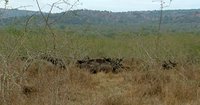
The Misunderstood Elephant
One Akagera elephant has made a splash on the international news scene. Last year, he overturned a French embassy vehicle full of picnickers and rummaged around in their baggage through the broken windows. While they stood and watched in terror, he made off with all their baguettes and sweets. Last month, the BBC online reported that he attacked a US embassy car when it got too close to him. The suspicion is that neither of these vehicles had a park guide with them, though; and the elephant seems more famous than he is notorious.
The elephant is called Mutwale, which is equivalent to 'chief' in Kinyarwanda. He is around forty years old, and has lived most of his life in the park. When Akagera reopened in 1960, after Rwanda declared its independence from Belgium, the directors transported an elephant herd from southern Rwanda to Akagera in order to establish a large population in the park. Mutwale was a baby in the herd when they were transported to their new home, and according to our guide he was the biggest and strongest young male for many years.
In the BBC article, a scientist claimed that the elephant was attacking people because he was lonely and grief-stricken. Our guide agreed and explained Mutwale's sad history. After years of fighting to maintain his dominance, Mutwale lost his tusks in a particularly bad row. Immediately he lost his social status and was exiled from the herd. In his subsequent wanderings through the park, he eventually became acquainted with a man who was kind to him and fed him sugarcane. The man lived in a small fishing camp on Lake Ihema, the southernmost lake in the park. The rest of the elephants lived in the northern region of the park, so Mutwale made his home near the man's house. Supposedly he was less lonely in his exile because he had someone to keep him company. During the war, though, the man disappeared and Mutwale was shot by a soldier. He did not die, but now he is very wary of intruders.
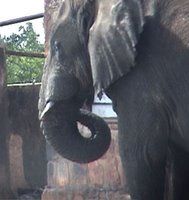
Elephants have incredible memories, as the saying goes, and Mutwale is no exception. In my amateur opinion, he is as conflicted about humanity as any other victim of violence. He remembers both kindness and pain, and a new encounter with people can trigger either comfort or fear and anger.
Mutwale still lives at the fishing camp, which is now a haunted looking place. The only time he ever leaves is when the other elephants pass through the area - then he disappears until they are gone. When we saw him on our first drive, he was contentedly eating sugar out of the hand of a guard at the camp; but the buildings in the camp are wrecked from his fits of anger. The tin roofs are mostly torn off and thrown about, walls knocked down, windows broken, boats from the lake littering the yard. It is as though he is searching for his friend.
The Uglies
Two animals vie for the distinction of Weirdest Looking. In Kinyarwanda, the word for hippopotamus is appropriately chunky: imvubu. All you can see of these awkward, shuffling animals as they float in the water is their whiskery noses, tiny ears, and massive round backs, like a bunch of overfilled balloons ready to pop. As if looking odd is not enough, hippos occasionally let out deep, rolling Vincent Price chuckles to communicate with each other.
In Kinyarwanda, the word for hippopotamus is appropriately chunky: imvubu. All you can see of these awkward, shuffling animals as they float in the water is their whiskery noses, tiny ears, and massive round backs, like a bunch of overfilled balloons ready to pop. As if looking odd is not enough, hippos occasionally let out deep, rolling Vincent Price chuckles to communicate with each other.
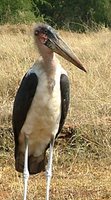 The marabou stork is as spindly as the hippo is roly-poly. These huge birds lurch around the lakeshores as precariously as old men in nursing homes. True to their rotten corpse-like looks, these birds are among the largest scavengers in the park. The feathers on their heads are fuzzy in a chemotherapy recovery style, and they look like they are wearing blouse that is unbuttoned one hole too many. In the early mornings they can be found in groups along the lakeshores, cleaning up after the previous night's kills.
The marabou stork is as spindly as the hippo is roly-poly. These huge birds lurch around the lakeshores as precariously as old men in nursing homes. True to their rotten corpse-like looks, these birds are among the largest scavengers in the park. The feathers on their heads are fuzzy in a chemotherapy recovery style, and they look like they are wearing blouse that is unbuttoned one hole too many. In the early mornings they can be found in groups along the lakeshores, cleaning up after the previous night's kills.
The Domestics
The most common animal in Akagera is, anticlimactically, the cow. Local landowners in the province commonly measure their wealth in cows, and having a herd numbering over fifty is not unusual for many of the local herders who have had cows in their families for generations.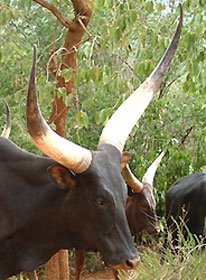 Because the park contains twelve lakes, herdsmen tend to water their cattle inside its boundaries, a practice which has stirred conflict between local advocates and conservationists. Until the debate is resolved, cows will continue to be a part of the wildlife viewing experience at Akagera.
Because the park contains twelve lakes, herdsmen tend to water their cattle inside its boundaries, a practice which has stirred conflict between local advocates and conservationists. Until the debate is resolved, cows will continue to be a part of the wildlife viewing experience at Akagera.
Rwandan cows are more interesting than you might imagine because they have spectacular weapons attached to their heads. The Ankole is a longhorn variety that, unless you live in rural Texas, is quite a head turner. Despite their fierce appearance, the breed is peaceful and obedient, filing one at a time out of the way of traffic.
The Verdict
As far as African safaris go, Akagera provides a unique opportunity: one can spot an animal, turn off the engine, and observe it peacefully without having five other Land Rovers converge on the scene. If you have access to private transportation and can tolerate a mediocre hotel's monopoly, Akagera is a worthwhile trip to an isolated - and possibly endangered - wilderness.

Rwanda is a tiny country, but it offers great variety in its landscape. Western Rwanda, like the neighboring Congo, is famous for its volcanoes, deep forests, and mountain gorilla populations. Akagera National Park is entirely different.
 Located in the east on the Tanzanian border, the park is the only place in the country where a visitor can experience the classic African safari: savannah bush land, giraffes, zebra, crocodiles, and hippos. Going on safari in Akagera, however, is not as much of a vacation as it is in other countries (see BLOG). Seeing the park itself is absolutely worth the trip, but arranging transportation and accommodation was more stressful than it should have been.
Located in the east on the Tanzanian border, the park is the only place in the country where a visitor can experience the classic African safari: savannah bush land, giraffes, zebra, crocodiles, and hippos. Going on safari in Akagera, however, is not as much of a vacation as it is in other countries (see BLOG). Seeing the park itself is absolutely worth the trip, but arranging transportation and accommodation was more stressful than it should have been. To be fair, Internet research is a dangerous thing. Naively, I believed that a random blogger's picture of Akagera Game Lodge was in fact depicting the Akagera Game Lodge, and I expected rustic comfort. After our bouncy, dusty journey to the park, however, I was not greeted by the sight of cozy thatched chalets in the bush. Nor was I welcomed by the sound of cooing doves or laughing hippos. Instead, brick walls and metal staircases loomed in front of me as I jumped out of the car. In place of a watering hole, an artificially blue swimming pool peeked out from the back garden.
The lodge is, in fact, a pleasant enough place. It has tasty food, decent wine, comfortable rooms, and a trilingual staff. But it practically bustles with activity until dark - I am beginning to understand that Rwandan hotels always seem crowded until dinnertime, when everyone who came to sip Coke beside the swimming pool goes home - and it is far too people-centric to be truly relaxing. One does not leave with the impression that man and beast coexist peacefully, which is a shame because the park itself is so scenic and tranquil.
When Animals Ruled the Earth
The best hour I spent at the lodge was from 5:30 to 6:30 am before everyone else was awake. Urged by an earnest travel companion, I rose early, layered on several sweaters, shuffled out to the poolside deck, plunked obediently into a chair, and waited for the orange sun to pull itself above the clouds.
Gradually, I became aware that the neatly shingled hotel roof was covered with large bumps. My ears registered scratching, and the shapes began to move. One shrieked. A troop of twenty baboons had parked themselves on the roof. All of them, like monks, faced the sunrise; and as the sun's light crawled across the roof, some of them began to play. As my companion poetically noted, the entire lodge suddenly became their jungle gym. They swung from balconies, climbed columns, perched on tables, and slid down railings. On the upper patio, a waiter suddenly appeared from the restaurant carrying a large room service tray. Several baboons watched him go by as they ripped flowers out of the planters, chewed off the roots, and then tossed them into the courtyard below. Three more tailed him down the hall.

As the light increased, the baboons were gradually shown the door by the hotel staff, who circled the grounds waving their arms and yelling. By eight, the whole troop had galloped huffily back into the bush.
We weren't the only ones enjoying a stunning buffet that morning. On my way to breakfast I learned that baboons are omnivores. As I approached the restaurant, I saw a man quietly sweeping up the bloody sparrows' wings that were scattered among the debris of potting soil, chewed up plants, and feathers. My delight at the thought of the lodge's assortment of freshly made omelets was somewhat diminished as I picked my way around the mutilated birds.
Mutual Fascination
Our first game drive was a short tour near the lodge, and it was wildly successful. I expected neither volume nor variety of animals, as Akagera has been called an evaporating park. Not only have war and poaching severely deplete the number of animals living in the park, but 65 percent of the land has been confiscated and redistributed to returned refugees. In our first two hours, though, we were pleasantly surprised by both the beauty of the land and its variety of wildlife.
Despite the human turmoil that they have witnessed, the Akagera animals are not shy. After thirty minutes of weaving up and down the red rocky slopes, our vehicle emerged into a thorny clearing dotted with acacia trees. We growled along for a minute and then shuddered to a stop. The guide told us to climb onto the top of the car. Soon we spotted a pair of giraffes, a mother and baby, approaching across the clearing. The thorn bushes were four feet tall, so all we could see were two spindly necks bobbing towards us. Suddenly the huge animals burst into the path right in front of our car. Both of them paused, earnestly studying us. The baby was especially curious about the funny creatures in front of him and stared for a long time. Then his mother rustled back into the brush, ambling off into the distance, and he followed.

Later on, we passed by a herd of sleeping buffalo. I only mention this encounter because our guide suggested that we try to wake them up by driving into them. To his disappointment, all of us (especially the driver) voted down this scheme; but when I spotted a baby bush bunny camouflaged in the tall grass, he excitedly jumped out of the car to try and catch it. All the buffalo jumped up and snorted in alarm at his sudden movement. We begged him to get back in the car, and he grinned triumphantly as we drove off.

The Misunderstood Elephant
One Akagera elephant has made a splash on the international news scene. Last year, he overturned a French embassy vehicle full of picnickers and rummaged around in their baggage through the broken windows. While they stood and watched in terror, he made off with all their baguettes and sweets. Last month, the BBC online reported that he attacked a US embassy car when it got too close to him. The suspicion is that neither of these vehicles had a park guide with them, though; and the elephant seems more famous than he is notorious.
The elephant is called Mutwale, which is equivalent to 'chief' in Kinyarwanda. He is around forty years old, and has lived most of his life in the park. When Akagera reopened in 1960, after Rwanda declared its independence from Belgium, the directors transported an elephant herd from southern Rwanda to Akagera in order to establish a large population in the park. Mutwale was a baby in the herd when they were transported to their new home, and according to our guide he was the biggest and strongest young male for many years.
In the BBC article, a scientist claimed that the elephant was attacking people because he was lonely and grief-stricken. Our guide agreed and explained Mutwale's sad history. After years of fighting to maintain his dominance, Mutwale lost his tusks in a particularly bad row. Immediately he lost his social status and was exiled from the herd. In his subsequent wanderings through the park, he eventually became acquainted with a man who was kind to him and fed him sugarcane. The man lived in a small fishing camp on Lake Ihema, the southernmost lake in the park. The rest of the elephants lived in the northern region of the park, so Mutwale made his home near the man's house. Supposedly he was less lonely in his exile because he had someone to keep him company. During the war, though, the man disappeared and Mutwale was shot by a soldier. He did not die, but now he is very wary of intruders.

Elephants have incredible memories, as the saying goes, and Mutwale is no exception. In my amateur opinion, he is as conflicted about humanity as any other victim of violence. He remembers both kindness and pain, and a new encounter with people can trigger either comfort or fear and anger.
Mutwale still lives at the fishing camp, which is now a haunted looking place. The only time he ever leaves is when the other elephants pass through the area - then he disappears until they are gone. When we saw him on our first drive, he was contentedly eating sugar out of the hand of a guard at the camp; but the buildings in the camp are wrecked from his fits of anger. The tin roofs are mostly torn off and thrown about, walls knocked down, windows broken, boats from the lake littering the yard. It is as though he is searching for his friend.
The Uglies
Two animals vie for the distinction of Weirdest Looking.
 In Kinyarwanda, the word for hippopotamus is appropriately chunky: imvubu. All you can see of these awkward, shuffling animals as they float in the water is their whiskery noses, tiny ears, and massive round backs, like a bunch of overfilled balloons ready to pop. As if looking odd is not enough, hippos occasionally let out deep, rolling Vincent Price chuckles to communicate with each other.
In Kinyarwanda, the word for hippopotamus is appropriately chunky: imvubu. All you can see of these awkward, shuffling animals as they float in the water is their whiskery noses, tiny ears, and massive round backs, like a bunch of overfilled balloons ready to pop. As if looking odd is not enough, hippos occasionally let out deep, rolling Vincent Price chuckles to communicate with each other.  The marabou stork is as spindly as the hippo is roly-poly. These huge birds lurch around the lakeshores as precariously as old men in nursing homes. True to their rotten corpse-like looks, these birds are among the largest scavengers in the park. The feathers on their heads are fuzzy in a chemotherapy recovery style, and they look like they are wearing blouse that is unbuttoned one hole too many. In the early mornings they can be found in groups along the lakeshores, cleaning up after the previous night's kills.
The marabou stork is as spindly as the hippo is roly-poly. These huge birds lurch around the lakeshores as precariously as old men in nursing homes. True to their rotten corpse-like looks, these birds are among the largest scavengers in the park. The feathers on their heads are fuzzy in a chemotherapy recovery style, and they look like they are wearing blouse that is unbuttoned one hole too many. In the early mornings they can be found in groups along the lakeshores, cleaning up after the previous night's kills.The Domestics
The most common animal in Akagera is, anticlimactically, the cow. Local landowners in the province commonly measure their wealth in cows, and having a herd numbering over fifty is not unusual for many of the local herders who have had cows in their families for generations.
 Because the park contains twelve lakes, herdsmen tend to water their cattle inside its boundaries, a practice which has stirred conflict between local advocates and conservationists. Until the debate is resolved, cows will continue to be a part of the wildlife viewing experience at Akagera.
Because the park contains twelve lakes, herdsmen tend to water their cattle inside its boundaries, a practice which has stirred conflict between local advocates and conservationists. Until the debate is resolved, cows will continue to be a part of the wildlife viewing experience at Akagera. Rwandan cows are more interesting than you might imagine because they have spectacular weapons attached to their heads. The Ankole is a longhorn variety that, unless you live in rural Texas, is quite a head turner. Despite their fierce appearance, the breed is peaceful and obedient, filing one at a time out of the way of traffic.
The Verdict
As far as African safaris go, Akagera provides a unique opportunity: one can spot an animal, turn off the engine, and observe it peacefully without having five other Land Rovers converge on the scene. If you have access to private transportation and can tolerate a mediocre hotel's monopoly, Akagera is a worthwhile trip to an isolated - and possibly endangered - wilderness.





<< Home